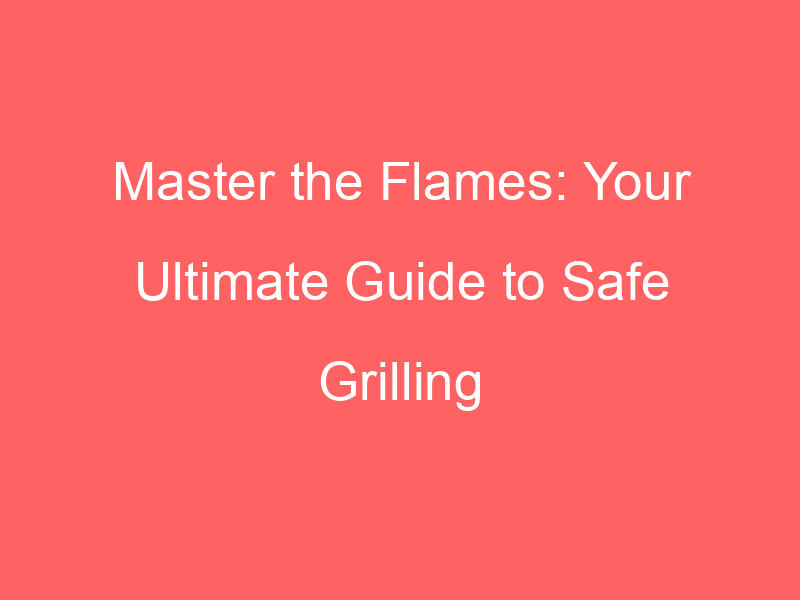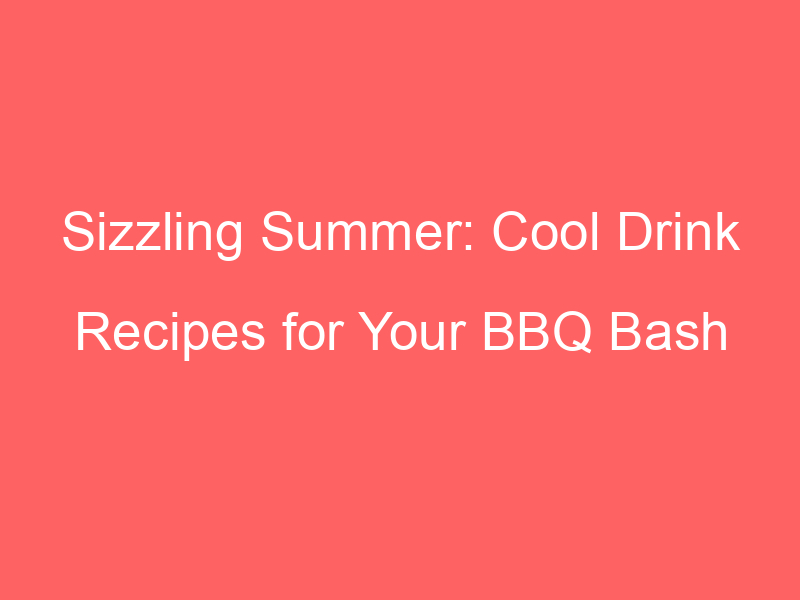Introduction to Grilling Safety
Grilling is a popular activity enjoyed by many, especially during the warm summer months. However, it’s crucial to understand the importance of safety while grilling. This article will discuss the significance of grilling safety and debunk some common misconceptions about it.
- Importance of Grilling Safety
- Common Misconceptions about Grilling Safety
Grilling safety is paramount for several reasons. Firstly, it helps prevent accidents that could lead to severe injuries. According to the National Fire Protection Association, nearly 10,000 home fires are started by grills each year. Secondly, safe grilling practices ensure that the food you cook is safe to eat. Improper grilling can lead to foodborne illnesses, which can be harmful to your health. Lastly, understanding grilling safety can enhance your overall grilling experience, making it more enjoyable and stress-free.
There are several misconceptions about grilling safety that can lead to dangerous practices. One common misconception is that it’s safe to use a grill indoors or in a closed space. This is not true; grilling should always be done outdoors to prevent the accumulation of harmful carbon monoxide. Another misconception is that it’s okay to leave a grill unattended while it’s on. This can lead to accidents, as a sudden flare-up could occur when you’re not around to control it. It’s essential to debunk these misconceptions to ensure safe grilling practices.
In the following sections, we will delve deeper into grilling safety tips, advanced techniques, outdoor cooking safety, grill safety precautions, rules and regulations, and how to master the flames safely. Stay tuned to become a grilling safety expert!
Grilling Safety Tips: The Basics
Grilling is a fun and delicious way to cook food, but it’s important to keep safety in mind. Here are some basic tips to help you grill safely and effectively.
Safe BBQ Practices
When it comes to barbecuing, safety should always be your top priority. Here are some practices to keep in mind:
- Keeping the grill clean: A clean grill is a safe grill. Leftover food particles and grease can ignite and cause a fire. Make sure to clean your grill after each use. A simple scrub with a grill brush can do the trick. Also, remember to check and clean the drip tray regularly.
- Maintaining a safe distance from the grill: Always keep the grill at least 10 feet away from your house or any other structures. This includes overhanging branches or awnings. Never grill indoors or in enclosed spaces, as this can lead to carbon monoxide poisoning.
- Properly lighting the grill: If you’re using a gas grill, always open the lid before lighting it to prevent a buildup of gas. If you’re using a charcoal grill, use a charcoal chimney or an electric starter instead of lighter fluid to prevent dangerous flare-ups.
By following these basic grilling safety tips, you can ensure a safe and enjoyable BBQ experience for everyone. Remember, safety first!
Ultimate Grilling Guide: Advanced Techniques
Grilling is an art, and like any art, it requires practice and knowledge of advanced techniques. In this section, we will delve into some of these techniques that can take your grilling game to the next level. But remember, safety always comes first.
Safe Grilling Techniques
Even when you’re using advanced grilling techniques, safety should never be compromised. Here are some safety measures to keep in mind:
- Controlling flare-ups: Flare-ups can happen when fat drips onto the heat source, causing a sudden burst of flame. To control flare-ups, keep a spray bottle of water nearby. When a flare-up occurs, spritz it with water to dampen the flame. However, don’t douse the flames completely as this can cause your food to become soggy.
- Using the right tools for grilling: Using the right tools can make a big difference in your grilling experience. Long-handled tongs and spatulas can help you handle food without getting too close to the heat. A grill brush can help you keep the grates clean, and a meat thermometer can ensure your food is cooked to the right temperature.
- Properly handling raw and cooked food: Cross-contamination is a common food safety issue. Always use separate utensils and plates for raw and cooked food. Also, remember to wash your hands thoroughly after handling raw meat.
By practicing these advanced techniques and safety measures, you can ensure that your grilling experience is both enjoyable and safe. Remember, the key to grilling success is patience, practice, and a respect for the flame.
| Technique | Description |
|---|---|
| Controlling flare-ups | Keep a spray bottle of water nearby to dampen sudden bursts of flame. |
| Using the right tools | Use long-handled tongs, spatulas, a grill brush, and a meat thermometer for a safe grilling experience. |
| Properly handling raw and cooked food | Use separate utensils and plates for raw and cooked food to avoid cross-contamination. |
Outdoor Cooking Safety: Beyond the Grill
Outdoor cooking is a cherished pastime for many, but it also comes with its own set of safety concerns. Beyond the grill, there are other elements to consider to ensure a safe and enjoyable experience. Let’s delve into some key aspects of outdoor cooking safety.
Preventing Grill Accidents
Preventing accidents before they happen is the best way to ensure safety. Here are some crucial steps to take:
- Safe use of propane and charcoal
- What to do in case of a fire
- First aid for common grilling injuries
Propane and charcoal are common fuels for grilling, but they can be dangerous if not handled properly. Always check for leaks in your propane tank before use. If you’re using charcoal, never add lighter fluid to an already lit fire as it can cause a flare-up. Keep your grill clean to prevent build-up of grease that can lead to a fire.
Despite your best efforts, fires can still occur. If a fire breaks out on your grill, close the lid to cut off the oxygen supply. For larger fires, use a fire extinguisher and call 911. Never attempt to put out a grease fire with water, as it can cause the fire to spread.
Common grilling injuries include burns and cuts. For minor burns, cool the area under running water and cover it with a sterile dressing. For cuts, clean the wound and apply pressure to stop bleeding. In both cases, seek medical attention if the injury is severe or if you’re unsure how to treat it.
Remember, safety should always be your top priority when grilling. By following these guidelines, you can enjoy a fun and safe outdoor cooking experience.
Grill Safety Precactions: Equipment and Gear
When it comes to grilling, safety should always be your top priority. This section will guide you through the essential grilling safety equipment, how to use them properly, and when it’s time to replace them.
Grilling Safety Equipment
Let’s delve into the world of grilling safety equipment. The right gear can make a significant difference in ensuring a safe and enjoyable grilling experience.
- Essential safety gear for grilling
- How to properly use safety equipment
- When to replace your grilling safety equipment
There are several pieces of safety equipment that are crucial for grilling. These include a fire extinguisher, a pair of heat-resistant gloves, a long-handled spatula and tongs, and a grill brush. A fire extinguisher is a must-have in case of flare-ups. Heat-resistant gloves protect your hands and arms from burns. Long-handled tools keep your hands at a safe distance from the heat, and a grill brush is used for cleaning the grill grates to prevent dangerous buildup.
Knowing how to use your safety equipment is just as important as having it. Always keep your fire extinguisher within reach and know how to operate it. Wear your heat-resistant gloves whenever you’re handling hot items. Use your long-handled tools to flip and move food on the grill. After each grilling session, clean your grill grates with the grill brush to remove any leftover food particles and grease.
Regular inspection of your grilling safety equipment is crucial. Replace your fire extinguisher if it’s expired or if it’s been used. Heat-resistant gloves should be replaced if they’re worn or damaged. Long-handled tools and grill brushes should be replaced when they start to wear out or if the bristles on the brush become loose, as they can be a potential hazard if they end up in your food.
Remember, grilling is a fun activity, but it’s important to prioritize safety. By using the right equipment and following these guidelines, you can ensure a safe and enjoyable grilling experience for everyone.
Safety Measures for Grilling: Rules and Regulations
Grilling is a favorite pastime for many, but it’s important to remember that safety should always come first. In this section, we’ll discuss the rules and regulations that you should be aware of when grilling, whether you’re in your backyard or a public space. We’ll also touch on how to keep kids and pets safe around the grill.
BBQ Safety Guide
- Local laws and regulations for outdoor grilling
- Best practices for grilling in public spaces
- Grilling safety for kids and pets
Before you fire up your grill, it’s crucial to understand your local laws and regulations. Some areas may have restrictions on the type of grill you can use, the time of day you can grill, or even where you can set up your grill. For example, in some cities, charcoal grills are not allowed on balconies or patios of multi-family residences due to the risk of fire. Always check with your local fire department or city council to ensure you’re grilling legally and safely.
When grilling in public spaces, such as parks or campgrounds, there are additional considerations to keep in mind. Always use the designated grilling areas and follow all posted rules. Never leave your grill unattended and ensure it’s fully extinguished before you leave. Remember, you’re sharing the space with others, so be considerate and clean up after yourself.
Children and pets are naturally curious, which can lead to dangerous situations around a hot grill. Establish a safety zone around the grill and teach kids to stay outside of it. Never leave the grill unattended when children or pets are around. Keep all grilling tools out of reach and ensure the grill is cool before allowing children or pets near it. Remember, safety is a priority when it comes to grilling.
In conclusion, grilling can be a fun and enjoyable activity for the whole family. However, it’s important to always keep safety in mind. By following these rules and regulations, you can ensure a safe and enjoyable grilling experience for everyone.
Conclusion: Mastering the Flames Safely
As we reach the end of our comprehensive guide on grilling safety, it’s crucial to remember that mastering the art of grilling isn’t just about achieving the perfect sear on your steak. It’s also about ensuring the safety of yourself and those around you.
- Recap of grilling safety tips
Let’s quickly recap the key safety tips we’ve covered:
| Grilling Safety Tips |
|---|
| Always supervise the grill when in use. |
| Keep children and pets away from the grill area. |
| Ensure the grill is stable and set up on a flat surface. |
| Regularly clean your grill to prevent fat and grease build-up. |
| Use long-handled tools designed for grilling to keep your hands and face away from the heat. |
| Never leave your grill unattended. |
- Importance of continuous learning in grilling safety
Grilling safety isn’t a one-time lesson. It’s a continuous learning process. As technology advances, new grilling equipment and safety gear are introduced to the market. Staying updated with these changes can help you grill safely and efficiently.
Remember, “Knowledge is power. Information is liberating. Education is the premise of progress, in every society, in every family.” – Kofi Annan. This quote perfectly encapsulates the importance of continuous learning in grilling safety. By staying informed and educated, you can ensure that every grilling session is a safe and enjoyable experience for everyone involved.
So, keep these tips in mind, stay safe, and happy grilling!






